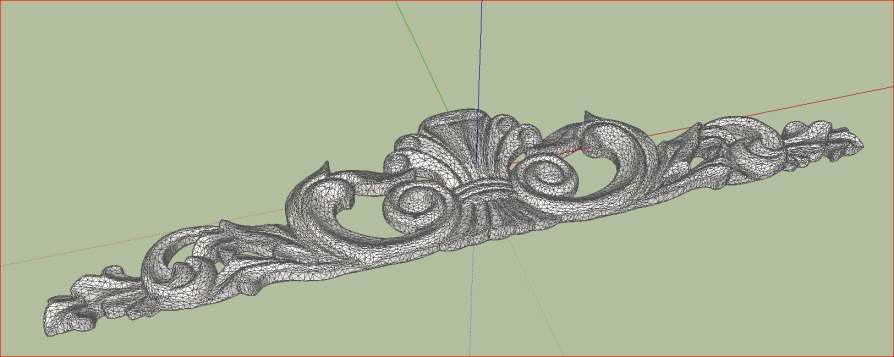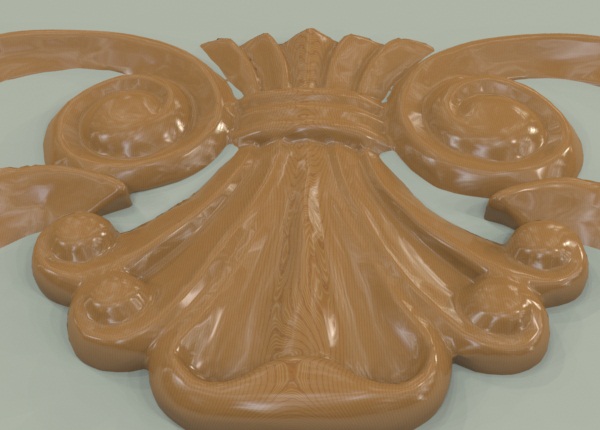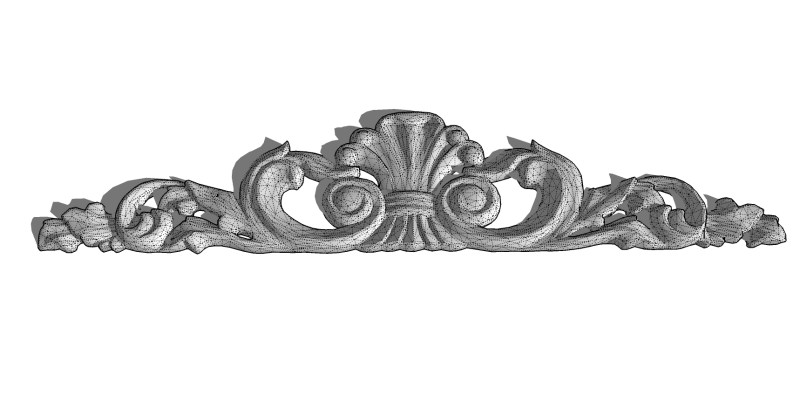Simulate a Wood Carving?
-
Take a look at this image,

Ya see the center clam shell carvings, the tapered flutes? Is it possible to duplicate these in a concentric 90 degree layout? Basically I want to create a 90 degree corner block that contains a tapered carving similar to the tapered flutes in the pic. A repeating concentric pattern would be great.
I know how to create flutes, but making them tapered and going from full depth to almost no depth is killing me.
-
Maybe this would give you some ideas about how to make those tapered flutes? The ones I did are all the same and, compared to your example, inside out but the process would be similar. You only need to draw half of it of course.
Or, this is a SketchUp model.
-
Dave, how ya been? Ya, that is exactly what I am looking for!
Thanks!
Mark
-
Mark,
I'm doing well. You?
Have a play with basically what I did in the video. I expect you aren't planning to use the applique to create a pattern but rather to give the idea of what it would look like. So do things to keep it simple like only drawing half of it, making it a component and then make a mirrored copy of it for the other half. Use low segment counts for arcs and other curves so you don't end up with file bloat.
It's too bad that image isn't a better one.
cheers,
Dave
-
Hi Dave,
below a link where you can download 3D models as *stl files. Maybe it is helpfull.
Charly

-
Yes, indeed Charly. That's the same onlay I worked from although mine is less than 1 Mb in file size.
-
Simon had a good set of tutorials that may help out..http://forums.sketchucation.com/viewtopic.php?p=62185#p62185
-
Hi Dave,
I have no idea how you made the model in SketchUp. Would you even show us a start.
Charly
-
These wood carvings are a good use of solid wood materials in rendering packages.
Here I rendered the model with a solid wood texture (Which treats the model as if it were carved from the wood - sculpting the grain into the model.)

Here is a closeup of the solid wood grain detail:

-
That's nive UV mapping, Al. It is definitely not a nativeSketchUp, planar projection...
-
OK, I see. Nifty technique; I have to bow my head.
<bowing head smiley inserted here> -
@gaieus said:
That's [nice] UV mapping, Al. It is definitely not a nativeSketchUp, planar projection...
These solid textures - which many rendering packages can do - do not use UV mapping. Instead they define a 3D texture - defining how the wood grain appears based on location in 3D space, rather than a position on the surface - and then "cut" the wood out of the 3D texture.
I first saw it when we did our RenderMan interface to ARRIS Cad in the early 90's. But until we had a good sculpting system like SketchUp, it was hard to find good models to demonstrate the technique.
-
@dave r said:
Maybe this would give you some ideas about how to make those tapered flutes? The ones I did are all the same and, compared to your example, inside out but the process would be similar. You only need to draw half of it of course.
Dave, I'm having a hard time doing the rotation to create the "cone" along the 15 degree line as described in your videos. I created the curved and welded line that is to become the "petal" of the fan, along the blue axis. Selected the curved line then snapped the red axis with the rotate tool, but this is where I get lost, I must be missing a step somewhere cause when I try to rotate no matter what I try I end up with cylinder, it won't use the 15 degree line as it's rotation point.
I hope this explanation makes sense.
-
OK, figured out what I was doing wrong, I wasn't following the 15 degree line with holding the mouse button down.
But how did you make 6 separate new lines in one click like that?
-
@mgfranz said:
OK, figured out what I was doing wrong, I wasn't following the 15 degree line with holding the mouse button down.
But how did you make 6 separate new lines in one click like that?
Never mind, got that figured out too...

-
-
Thanks Pete. I haven't had time to do anything to show here so I'm glad you did.
-
Hi Pete,
I have reduced the polygons with Cinema 4D by 50%. But the quality seems worse than in your model. The size is still 1.81 MB. The method that you have achieved it? Or is it your secret?
Charly
-
Charly, I've been extremely busy at my day job doing some upgrades to our 70 anesthesia machines so I haven't even had time to open Pete's file to compare it to the way I managed to get the file size down. The way I did it, however was to split the carving in half along its line of symmetry. Then I deleted one half. There was a lot of excess geometry I could delete as well. My version doesn't have a back surface. These things are designed to be applied to another surface so the back isn't needed. Getting rid of it eliminated a large number of edges and faces. Once the half was cleaned up, I made it a component, copied it and flipped the copy. The seam line was then hidden so it looks like one piece.
-
Hi to All,
I have again a question to all SketchUp users. If you keep selecting the back of a high polygon model is always a lot to be polygons that are not included. And this has to be erased manually. Is there a trick to select all parts below the surface?
Charly
Advertisement










